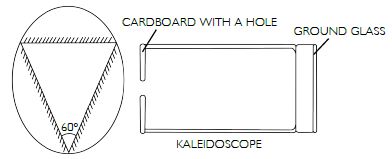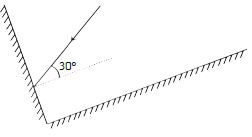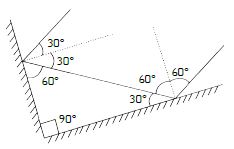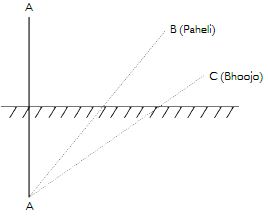Question 1:
Suppose you are in a dark room. Can you see objects in the room? Can you see objects outside the room? Explain.
Answer:
We see things only when light reflected by them enters our eyes. Since no light is reflected from the surface of the objects in a dark room, we are not able to see them. However, outside the room, where light is available, objects can reflect light and thus, we are able to see them.
Question 2:
Differentiate between regular and diffused reflection. Does diffused reflection mean the failure of the laws of reflection?
Answer:
Question 3:
Mention against each of the following whether regular or diffused reflection will take place when a beam of light strikes. Justify your answer in each case.
(a) Polished wooden table
(b) Chalk powder
(c) Cardboard surface
(d) Marble floor with water spread over it
(e) Mirror
(f) Piece of paper
Answer:
(a) A polished wooden table will have regular reflection because its surface is smooth.
(b) A chalk powder will give diffused reflection because the chalk powder particles are not smooth.
(c) Cardboard surface has minute irregularities on it, so it will have a diffused reflection.
(d) Marble stone with water spread over it will have regular reflection if the water is stable. However, if waves are formed, diffused reflection will take place.
(e) Any mirror has a shiny and smooth surface. Therefore, regular reflection will be observed.
(f) A piece of paper has a rough surface. Therefore, diffused reflection will be observed.
Question 4:
State the laws of reflection.
Answer:
The laws of reflection are as follows:
(a) The angle of incidence is always equal to the angle of reflection.
(b) The incident ray, the normal at the point of incidence and the reflected ray, all lie in the same plane.
Question 5:
Describe an activity to show that the incident ray, the reflected ray and the normal at the point of incidence lie in the same plane.
Answer:
Procedure:
(a) Fix a white sheet of paper on a drawing board in such a way that a small portion of it projects a little beyond the edge of the drawing board.
(b) Place a plane mirror strip on the sheet of paper and hold it vertically with a mirror stand.
(c) Throw a ray of light on the mirror using a torch. Look at the reflected ray. Make sure that the reflected ray extends to the projected portion of the paper.
(d) Bend the part of the projected portion on which the reflected ray falls. Now, bring the projected portion of the paper back to its original position and observe.
Observation: The entire sheet fixed on to the drawing board represents a plane. When the paper is bent, a new plane is formed which is different from the plane in which the incident ray and the normal lie. So the reflected ray is not seen.
Conclusion: The incident ray, the normal at the point of incidence and the reflected ray lie in the same plane.
Question 6:
A person 1 m in front of a plane mirror seems to be _______________ m from his image.
Answer:
1
Question 7:
If you touch your ____________ ear with the right hand in front of a plane mirror, it will be seen in the mirror that your right ear is touched with the ____________ .
Answer:
Left, left hand
Question 8:
The size of the pupil becomes ____________ when you see in dim light.
Answer:
Larger
Question 9:
Night birds have ____________ cones than rods in their eyes.
Answer:
Lesser
Question 10:
The angle of incidence is ___________ equal to the angle of reflection.
- Always
- Sometimes
- Under special conditions
- Never
Answer:
Always
Question 11:
Image formed by a plane mirror is
- virtual, behind the mirror and enlarged
- virtual, behind the mirror and of the same size as the object
- real at the surface of the mirror and enlarged
- real, behind the mirror and of the same size as the object.
Answer:
virtual, behind the mirror and of the same size as the object
Question 12:
Describe the construction of a kaleidoscope.
Answer:
A kaleidoscope is made up of three narrow strips of plane mirrors inclined at 60º to each other and enclosed in a tube. One end of the tube is closed by a ground glass plate on its inner side. The space between the mirrors is filled with coloured pieces of glass or broken bangles. A cardboard with a hole in the centre is fixed on the other end of the tube through which different patterns formed by the mirrors are seen.
Question 13:
Draw a labelled sketch of the human eye.
Answer:
Question 14:
Gurmit wanted to perform an activity to see the change in the size of the pupil by throwing light in the eyes using a laser torch (NCERT textbook activity 16.8). Her teacher advised her not to do so. Can you explain the basis of her teacher’s advice?
Answer:
Gurmit’s teacher advised her not to do so because laser light is harmful for the eyes. It can cause permanent damage when flashed directly in the eyes.
Question 15:
Explain how you can take care of your eyes.
Answer:
The following precautionary measures should be taken to care for eyes:
(a) We should wash our eyes frequently with cold water.
(b) We should not rub our eyes or touch them with dirty hands. If dust particles enter our eyes, we should wash our eyes with clean water.
(c) We must not look at the Sun or a powerful light directly.
(d) We should eat sufficient quantity of vitamin A enriched food like raw carrots, green vegetables, papaya, mango, eggs, milk, etc.
(e) We should maintain a suitable distance while reading or watching TV.
(f) An eye specialist should be consulted in case of any irritation or redness in the eyes.
Question 16:
What is the angle of incidence of a ray if the reflected ray is at an angle of 90 to the incident ray?
Answer:
If i = angle of incidence, and r = angle of reflection
Then, i + r = 90 (given)
But i = r (according to the laws of reflection)
i + i = 90
or, 2i = 90
or, r = i = 45
Therefore, the angle of incidence of the ray will be 45.
Question 17:
How many images of a candle will be formed if it is placed between two parallel plane mirrors separated by 40 cm?
Answer:
Infinite images of the candle will be formed if it is placed between two parallel plane mirrors.
Question 18:
Two mirrors meet at right angles. A ray of light is incident on one at an angle of 30° as shown in the figure below. Draw the reflected ray from the second mirror.
Answer:
Question 19:
Bhoojo stands at A just on the side of a plane mirror as shown in figure below. Can he see himself in the mirror? Also can he see the image of objects situated at P, Q and R?
Answer:
Bhoojo cannot see his own image. However, he can see images of objects P but not Q and R.
Question 20:
(a) Find out the position of the image of an object situated at A in the plane mirror (Figure given below).
(b) Can Paheli at B see this image?
(c) Can Bhoojo at C see this image?
(d) When Paheli moves from B to C, where does the image of A moves?
Answer:
(b) Yes, Paheli can see the image.
(c) Yes, Bhoojho can see this image.
(d) When Paheli moves from B to C, the image of A will not move.








